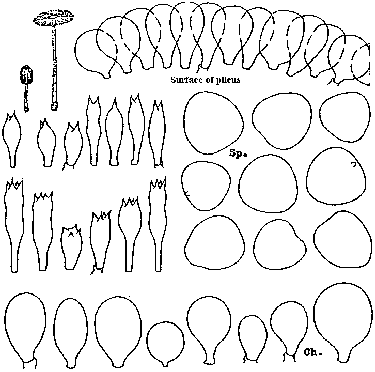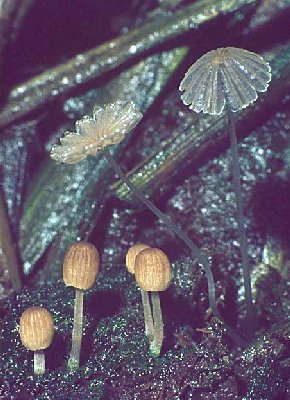Macroscopic features |
Pileus 3-8 mm, first ellipsoid, ovoid or cylindric-ellipsoid, then campanulate to convex, finally flat, orange-brown to greyish brown, later grey-brown and transparent with brownish centre (Mu. 5 YR 4-5/6, 7.5 YR 6/8, 7/8, 8/2, 10 YR 3.5/2; K. & W. 5B2-B5, 5B7; centre 6B8). Lamellae, L = 9-16, l = 0-1, free, but reaching stipe, white to grey, then blackish spotted. Stipe up to 50 x 0.5-1 mm, whitish, glabrous but at base often with loose fibrils; base somewhat clavate. |
Macroscopic features |
Spores 7.0-10.5 x 6.6-10.1 µm, Q = 0.95-1.15, av. Q = 1.00-1.05, av. L = 7.7-9.6 µm, av. B = 7.5-9.2 µm, heart-shaped, triangular with rounded angles, lentiform, with eccentric germ pore and convex to rounded base and rounded apex, dark red-brown. Basidia 16-32 x 8-10 µm, 4-spored, rarely all 2-spored (in the 2-spored form spores not noticeable larger), surrounded by 4-6 pseudoparaphyses. Pleurocystidia absent. Cheilocystidia 20-40 x 12-28 µm, (sub)globose or ellisoid. Pileipellis smooth, hymeniform, composed of spheropedunculate cells (20-45 x 12-25 µm) with short stalk at centre and sessile globose cells at margin. Clamp-connections present. |
Habitat & distribution |
On dung from several animals. Very common in the Netherlands. Wide-spread in Europe. |
Remarks |
Coprinus miser is easy to recognize because of the very small basidiocarps always growing on dung, the rounded triangular spores almost as broad as they are long, the absence of pleurocystidia and the (sub)globose to ellipsoid cheilocystidia. |

[Copyright © by Uljé]

[Copyright © by Hans Bender jbe8995374@aol.com]